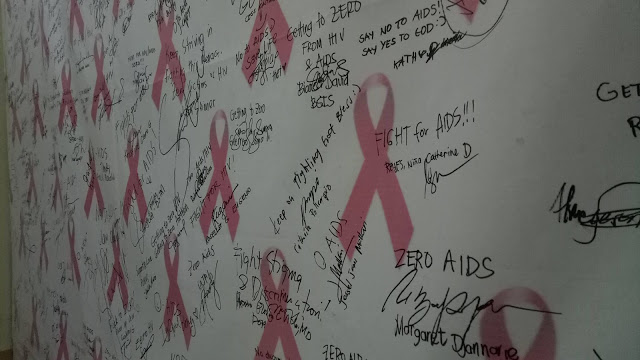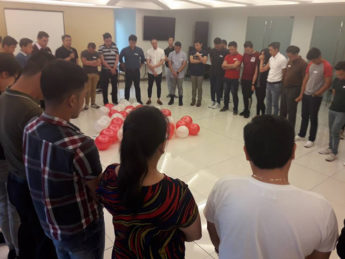In December 2016, the HIV/AIDS & ART Registry of the Philippines (HARP) reported there was an average of 26 new cases each day in the same year. But out of this number, how many represent the occurrence of HIV (Human Immunodeficiency Virus) infection among females?

that offers reproductive health care, STI screening, and treatment,
run by the local government of Angeles City
Out of the 750 newly reported cases in December 2016, 29 (3.87%) were female, while the cumulative cases from 1984 to December 2016 had a total of 39,622 reported cases where 2,810 (7.09%) were female. Compared to the number of men diagnosed with HIV, the report shows a small number. Does this permit us to pay lesser attention to women affected by this particular health and social issue? “The fact that there are women being infected with the virus, no matter what the number is, they should not be taken for granted,” said Mary Ann Cortez, Nurse and Focal Person for HIV in the Provincial Health Office of Pampanga. Here are 4 reasons we should listen to her:
Sexual Transmission is Easier
One may be infected with HIV through blood transfusion, sharing of needles, mother-to-child transmission, or unprotected penetrative sex (sex without the use of condoms) with a person living with HIV (PLHIV). And the most common way to transmit HIV according to various studies[1, 2, 3] is unprotected penetrative sex. While men and women do not differ in this category, it is a fact that during vaginal sex, HIV is easier transmitted from male to female than from female to male, which puts women at a higher risk.
Women-related Complications
Women face unique circumstances when dealing with HIV infection, including repeated vaginal yeast infections, severe pelvic inflammatory disease (PID), and a higher risk of cervical cancer. Furthermore, women may also experience problems related to their reproductive health, like changes in their menstrual cycle or even absence of periods (amenorrhea). Also, women living with HIV are more prone to osteoporosis.
Mother-to-child Transmission
HIV transmission is possible for a woman in her prenatal condition. This may be prevented but only with the help of regular intake of antiretroviral drugs – but aren’t those teratogenic (harmful) to the baby, you ask? AIDSinfo recommends[4, 5] that all women in their childbearing years should be well educated about this maternal issue. They should identify their childbearing intentions and make this their driving force throughout their treatment. Also, they must have a plasma viral load (concentration of HIV in blood plasma) below the limit of detection before conception. On the contrary, if a woman living with HIV does not want to get pregnant, she should know that all types of contraceptives can still be effective in her condition. These contraceptives prevent conception only and not the transmission of HIV, and that is why using condoms is still necessary.
With regard to ART (antiretroviral therapy), the effectiveness of the treatment regimen should be considered as well as the drug-to-drug interactions between the hormonal contraceptives and ART. Furthermore, AIDSinfo says the Hepatitis B status of the mother, the teratogenic effect of the regimen, and other adverse effects to the mother and fetus should be evaluated.
Other Social Issues Affecting Women
According to Mary Ann Cortez, there is a cause for concern that the number of newly diagnosed HIV cases among the youth is increasing. She connects this with the existing issue of teenage pregnancy. “Teenage pregnancy is there. This means that some young women are engaging in unprotected sexual activities, and the fact that they do means they are also at high risk of getting HIV,” she said.
Meanwhile, Dr. Verona Guevarra, the Reproductive Health and Wellness Chief of Bale Angeleno (Angeles City’s Social Hygiene Treatment Hub located in the red light district of the city) shared to us that before they ignited much effort in HIV and AIDS awareness and prevention, the trend in the number of HIV transmission based on sex in their city was different from the nationwide trend where more males get infected. This is because the said community is known to be a hub of transactional sex or sexual activity that involves paying or accepting money or both. “Before, we diagnosed more females because of the red light district here, where customers are both Filipinos and foreigners. But it is different now,” she said.
Since 2010, they have been implementing mandatory HIV counseling for all their registered sex workers, but HIV testing remains voluntary. Since then, the numbers in their scale slowly tuned in with the nationwide trend. To date, the HARP reported 66 (9%) of the total captured positive cases in December 2016 (750) engaged in transactional sex where 5 were females. Poverty remains the number one reason people in this industry do transactional sex. Poverty is everywhere, and so is transactional sex. All of these women [and men] should be reached.
Like social inclusion, economic progress, and gender equality, women also have an uphill battle against HIV and AIDS. Equality will also be our answer here – equality in the access of awareness regarding this matter. The number of women visiting the LoveYourself clinics are increasing in number. This is something good because HIV and AIDS is not a gay disease nor an LGBT issue alone; it requires everybody’s involvement.
Together, we want to change how you think about HIV. You might know women like them in your own life – they’re mothers, wives, daughters, students, caregivers, business owners. They’re just like you, and they’re just like me.
Alicia Keys, singer
LoveYourself conducts free HIV testing and counseling. For more information, click here.
Text and photo by Reiner “Meow” Grospe



